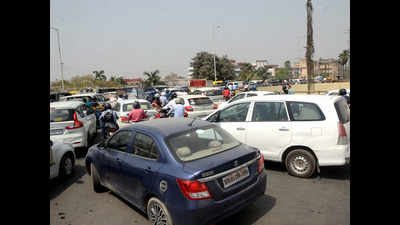- News
- City News
- patna News
- Patna, Muzaffarpur among 32 most polluted cities across world
Trending
This story is from March 18, 2021
Patna, Muzaffarpur among 32 most polluted cities across world

Muzaffarpur ranked 28th with an average annual PM 2.5 level of 74.3ug/m3 last year (81.2 in 2019), while Patna stood at 32nd spot
PATNA: The state capital and Muzaffarpur figure among the 32 most polluted cities globally, according to the ‘World Air Quality Report, 2020’ released by a Swiss company.
The report shows an alarming level of poor air quality in both cities as the average annual PM 2.5 (particulate matter less than 2.5 microns) was recorded above 55.5 micrograms per cubic metre (µg/m3), which comes under the ‘unhealthy’ category.
Muzaffarpur ranked 28th with an average annual PM 2.5 level of 74.3ug/m3 last year (81.2 in 2019), while Patna stood at 32nd spot with 68.4 ug/m3 (82.1 in 2019) of PM 2.5 level. With PM2.5 levels of 54ug/m3 and 46.3 ug/m3, Hajipur and Gaya respectively ranked 68th and 135th in the world.
Compared to 2019, the data shows a gradual improvement due to the Covid-19 lockdown for over four months starting mid-March.
As per the report, Patna and Muzaffarpur did not record a single day in 2020 where the pollution level was at the
Geological factors and anthropogenic (human) activities are the main reasons for the rise in air pollution in the state, said Ashok Ghosh, Bihar State Pollution Control Board chairman.
"More then two-third parts of Bihar have alluvial soil, which was formed due to the formation of the Himalayas. The alluvial soil is soft and significantly contributes to wind-blown dust. Due to the meandering of the Ganga, a large portion of the river bed has now dry sand. When the wind blows from the Himalayas, the dust particles get deposited across the cities," he said.
Ghosh told this newspaper that geological factors are not in control of BSPCB but by planting trees on river beds, PM 2.5 can be cut to some extent.
Ghosh said open construction of roads and buildings, vehicular emission especially from outdated vehicles and cloud of dust by vehicles, and reduction in green cover because of development activities are the three main reasons for worsening of air quality.
"We have written several letters to government departments for the use of screens during the construction but in vain. Using screen at construction sites can reduce pollution. Concrete pavements are important to control dust due to vehicle movement. Old vehicles need to be banned. Planting trees is also necessary to control air pollution," Ghosh said, adding that AQI consists not only of PM2.5 level but also other toxic gases, which always remain within limits in Muzaffarpur and Patna.
The global cities ranking report is based on PM2.5 data from 106 countries measured by ground-based monitoring stations, mostly operated by government agencies.
The report shows an alarming level of poor air quality in both cities as the average annual PM 2.5 (particulate matter less than 2.5 microns) was recorded above 55.5 micrograms per cubic metre (µg/m3), which comes under the ‘unhealthy’ category.
Muzaffarpur ranked 28th with an average annual PM 2.5 level of 74.3ug/m3 last year (81.2 in 2019), while Patna stood at 32nd spot with 68.4 ug/m3 (82.1 in 2019) of PM 2.5 level. With PM2.5 levels of 54ug/m3 and 46.3 ug/m3, Hajipur and Gaya respectively ranked 68th and 135th in the world.
Compared to 2019, the data shows a gradual improvement due to the Covid-19 lockdown for over four months starting mid-March.
Muzaffarpur has also shown poor performance in the Ease of Living Index 2020, a government survey of cities across the country released on March 4. The city found itself at the bottom of the list when surveyed on 13 different categories, including quality of life, sustainability, health, education among other parameters.
As per the report, Patna and Muzaffarpur did not record a single day in 2020 where the pollution level was at the
World Health Organization standard. Muzaffarpur’s air quality in January 2020 turned entered the 'very unhealthy' category while in other months, it was in the 'unhealthy' zone and unhealthy for sensitive groups.
Geological factors and anthropogenic (human) activities are the main reasons for the rise in air pollution in the state, said Ashok Ghosh, Bihar State Pollution Control Board chairman.
"More then two-third parts of Bihar have alluvial soil, which was formed due to the formation of the Himalayas. The alluvial soil is soft and significantly contributes to wind-blown dust. Due to the meandering of the Ganga, a large portion of the river bed has now dry sand. When the wind blows from the Himalayas, the dust particles get deposited across the cities," he said.
Ghosh told this newspaper that geological factors are not in control of BSPCB but by planting trees on river beds, PM 2.5 can be cut to some extent.
Ghosh said open construction of roads and buildings, vehicular emission especially from outdated vehicles and cloud of dust by vehicles, and reduction in green cover because of development activities are the three main reasons for worsening of air quality.
"We have written several letters to government departments for the use of screens during the construction but in vain. Using screen at construction sites can reduce pollution. Concrete pavements are important to control dust due to vehicle movement. Old vehicles need to be banned. Planting trees is also necessary to control air pollution," Ghosh said, adding that AQI consists not only of PM2.5 level but also other toxic gases, which always remain within limits in Muzaffarpur and Patna.
The global cities ranking report is based on PM2.5 data from 106 countries measured by ground-based monitoring stations, mostly operated by government agencies.
End of Article
FOLLOW US ON SOCIAL MEDIA











